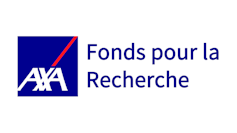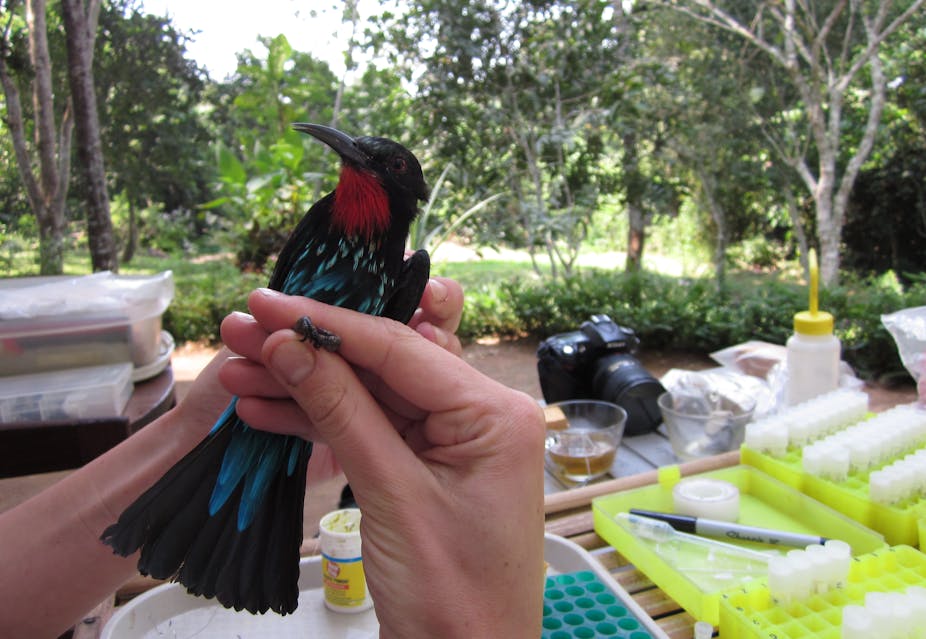In my research projects in ecology, I’m seeking to understand how interactions between birds and their parasites are affected by environmental degradation linked to human activities such as deforestation, intensive agriculture or climate change. This human impact has caused land cover and climate conditions to change, which has repercussions both on bird populations and on insects (such as mosquitoes) that spread pathogens to birds.
To gather data, I go on field trips with teammates and capture birds and mosquitoes (also known as “vectors”) in habitats with varying degrees of degradation and different environmental characteristics. This allows me to describe the diversity of parasites in natural populations and compare the proportion of infected birds in contrasting habitats.
During my research projects I have travelled widely, from the polar regions to equatorial forests. Field missions are the foundation of any research in the field of ecology, whether one-off trips or part of long-term monitoring. While conditions are sometimes rough, I find this time in the field to be a great source of wonder and inspiration.
This selection of photos will allow you to follow me in situ along the different stages of capture and sampling for my research into birds and their parasites.
Setting up the nets

In these photos taken in Alaska, we are setting up nets to capture passerine species. Thirteen sites were selected along a latitudinal gradient, from Anchorage at 61ºN (south of Alaska) to Coldfoot at 67ºN (beyond the Arctic Circle).
Net capture is the most commonly used method for passerine birds. However, it requires a relatively good knowledge of the terrain, to place them in the right spots. This is not an easy task in tundra landscapes, where the low vegetation makes it easy for birds to see the nets.
Why study bird populations in Alaska? Well, the arctic region is one of the areas where temperature increases have been the most noticeable in recent decades. Changes in the climate can have an impact on mosquito populations and blood parasites, as daily fluctuations in temperature affect their rate of development.
Our research was able to show that avian Plasmodium are present to latitudes up to 64ºN, but not above.
With regards to climate-change scenarios for the year 2080 (with higher temperatures throughout the entire region), we can predict that blood parasites are likely to spread geographically to latitudes where they are not currently found. In a not-so-distant future, birds will be exposed to parasites to which they are not immune, which could lead to potential population declines.
Banding the birds

Once a bird has been caught in the net, we have to carefully remove it. We then place a band around its leg, on the part called the tarsus, between the thigh bone and the foot. Once the band has been attached, we take a series of body measurements – length of the wing, tarsus, sometimes the beak, and weight. These measurements provide an indication of the bird’s physical condition. Each band has a unique number, which allows us to identify the bird if it is captured again. Every year, banded birds are recaptured, sometimes very far from where they were born or from their first caught.
All the data is sent to institutions (organisations or museums) in the countries where the birds are banded, and then to bigger databases, like the Euring Data Bank in Europe, or the North American Bird Banding Program.
These databases are extremely important – in particular, because they allow the distances and migration routes travelled by birds to be assessed. Recapturing banded birds from year to year also helps to estimate the population sizes and annual survival rates.
Taking blood samples

For our study conducted in Alaska from June to July 2011, we wanted to determine whether blood parasites (from the genus Plasmodium, Haemoproteus and Leucocytozoon) were present in birds. These parasites are very close to those that cause malaria in humans, with similar symptoms – fever and anaemia. Infected birds are physically weakened, which sometimes affects their investment in reproduction – fewer eggs and hatchlings, reduction in food brought to chicks. Some birds can also suffer from more serious symptoms and die.
Blood can be easily drawn from the brachial vein, in the bird’s wing, or in bigger birds, from the leg or jugular vein in the neck. Only a few drops are collected, using a capillary tube. The blood is placed in vials with alcohol or a special solution so that the DNA is preserved and does not deteriorate. The samples were then stored in freezers at San Francisco State University in the laboratory of Dr. Ravinder Sehgal.
DNA is then extracted from the blood sample – that of the bird as well as whatever might be present in its blood. Polymerase chain reaction (PCR) is used to amplify the blood parasite DNA and therefore detect the diversity of parasites and determine their prevalence (i.e., the percentage of infected birds in a population).
Catching insects

The insect vectors help us getting a clearer picture. Various techniques can be used to sample them. We can collect larvae in water, where they grow before emerging, while adults are caught with traps that attract them with light or CO2. Insects such as mosquitoes use a wide range of visual and chemical cues to find a host on which they can bit and get a blood meal. Like many insects, mosquitoes are drawn to light, but even more so to CO2 emissions from animal species. Other chemical clues, such as odors, help them find and choose their host.
As part of my current research project, conducted on the island of São Tomé, in the Gulf of Guinea (Africa), we placed light traps along a gradient of anthropogenic disturbance. This ranged from habitats that had been profoundly modified by humans (palm oil plantations) to more natural areas (secondary and native forests).
The main objective is to evaluate how monocultures change the community of vectors and their pathogens. Traps are attached to trees at different heights and activated at the end of the day to catch insects throughout the night. A battery powers a small fan that sucks up insects attracted by the light. In the morning, the fine mesh bags are collected.
Sorting

Because the light traps attract a whole crowd of insects, we need to sort them and only keep the families that are of interest to us. Entomologists collaborate with us on this, as they have the expertise necessary for morphological identification, a complicated task, especially in tropical areas where there is a huge diversity of species.
For example, out of the 3,500 known mosquito species, just over 2,000 are found between the Equator and 10º latitude, whereas barely 200 species are found above 50º latitude.
In the case of our study in São Tomé, we collected around 15 species of mosquitoes out of the 30 known to live in this archipelago. But what was surprising was the number of culicoides we found – dipterous vectors of avian parasites which also spread viruses to horses, ruminants (domestic and wild) and nematodes (roundworms) to humans.
We were able to identify nine species of culicoides, including seven that were not then known to be present on the island. This is due to the lack of entomological studies conducted on the archipelago, which has an incredible biodiversity.
Understanding how diseases emerge
Whether in Alaska or Central Africa, on the continent or in the islands, my research has shown that certain passerine species are experiencing disruptions in their pathogen community, due to human pressure. Homo sapiens is actually the only animal species that knowingly destroys its environment and endangers a large number of species, including itself.
It is therefore crucial to better understand how these anthropogenic activities change ecosystems and interactions between species. The emergence of infectious diseases – whether transmitted directly, or via a vector, from wild animals to domestic animals and humans (Dengue, Ebola, SARS, West Nile) – is a major concern at the heart of the current pandemic, now and for decades to come.


Axa Research Fund was created in 2007 to accelerate scientific understanding and encourage researchers to share their work with the public. It has provided support to around 650 projects worldwide, undertaken by researchers from 55 countries. To find out more, visit the Axa Research Fund website or follow on Twitter @AXAResearchFund.
Translated from the French by Rosie Marsland for Fast ForWord


